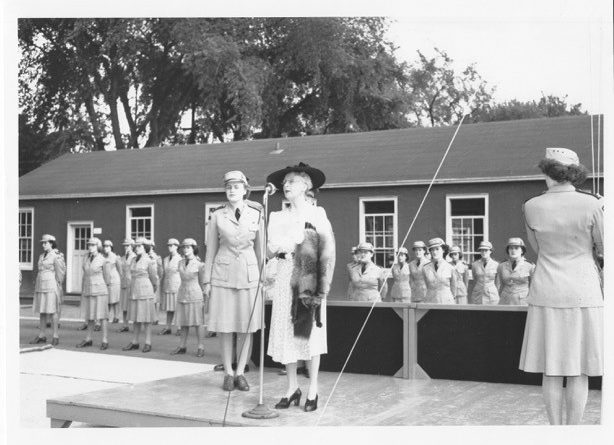World War II’s big impact on this neighbourhood
François Bregha
This year, 2019, marks the eightieth anniversary of the start of the Second World War. World War II had a lasting impact on Sandy Hill, notably in the conversion of former private homes into offices, diplomatic missions or barracks. Once converted, these homes did not return to their former residential use when the war ended. The war thus cemented a slow transformation in Sandy Hill that had already begun earlier, from a largely upper-class neighbourhood distinguished by large mansions, into a mixed neighbourhood featuring smaller houses, higher density and a greater institutional footprint.
Three major factors accounted for this transformation. First, Sandy Hill acquired a noticeable military presence in the second half of the war, particularly along Laurier Avenue East. Several large Sandy Hill mansions were re-purposed to serve the war effort, among them:
- Kildare Annex (now Amnesty International at 312 Laurier Ave.) became a barracks for the Canadian Women’s Army Corps and would house the Canadian Army Provost Corps immediately after the war;
- Bremner House (345 Laurier Ave. E., now an apartment building) became the Examination Unit, Canada’s espionage centre;
- Munross (formerly the house of Ambrose O’Brien, now the Cordon Bleu at 453 Laurier Ave. E.) was used as a residence for the Women’s Royal Canadian Navy Service and was renamed Kingsmill House in 1942);
- Kildare House (323 Chapel), formerly the home of James Woods, served as barracks during the war;
- Hardy House (now the Polish embassy at 443 Daly Ave.) provided officers’ training for the Women’s Royal Canadian Navy Service.

Department of National Defense
In addition, the government built the Varsity Oval Barracks on the University of Ottawa’s athletic field south of Somerset Street in 1942. Composed of eight buildings designed to house 400 women of the Canadian Women’s Army Corps, the barracks were sold to the University in 1946 and became classrooms and residences for the new faculties of medicine, engineering and sciences. At least one of these buildings stood until 1972.
A second change to Sandy Hill as a result of the war arose from Canada’s increasing international importance. This new status led more countries to open diplomatic missions in Ottawa, several of which were in Sandy Hill: the Soviet government acquired the former Booth house at 285 Charlotte St. in 1943; the Australian High Commission replaced the German consulate at 407 Wilbrod St. in 1940; the Royal Norwegian Legation was housed at 192 Daly Ave.; the Free French government opened a mission at 464 Wilbrod St. The Belgian government moved from a more modest address to Stadacona Hall on Laurier Avenue after the war.
The third change arose from the huge backlog in residential construction that had accumulated as a result of the Great Depression and the war, and the need to accommodate returning veterans. While the post-war construction boom was Canada-wide, in Sandy Hill, it was most evident in building up Strathcona Heights which until then had stood largely empty.
These, of course, were not the war’s only lasting impacts on Sandy Hill. As the memorials in our churches and at the University remind us, several Sandy Hill men died at war, including nine from St Alban’s, 16 from All Saints and 20 from St Joseph’s. In addition, 69 University of Ottawa students or graduates perished in the war. While not all were from Sandy Hill, many were.
Daily life, of course, was also profoundly affected by the war. Rationing and war-induced shortages reduced the variety of goods and food available to all. An indication of the collective belt-tightening is that the number of private cars on Ottawa’s roads fell by 13 per cent during the war even as the city’s population grew by 17 per cent. All media were dominated by war news. Drives to collect blood for the Red Cross, sell Victory bonds or collect metals for recycling were frequent. In politics, the conscription crisis split the country along linguistic lines as it had in 1917. These changes, however, were temporary and life returned to normal as war-time restrictions were gradually lifted.
But it did not return to what it had been pre-war. In September 1945, Igor Gouzenko walked out of the Soviet embassy on Charlotte Street carrying documents revealing the existence of a Soviet spy ring in Canada, kicking off a new Cold War between the West and the Soviet Union. One of the persons he denounced lived in Sandy Hill and was jailed. Sandy Hill would never be the same after the war.
